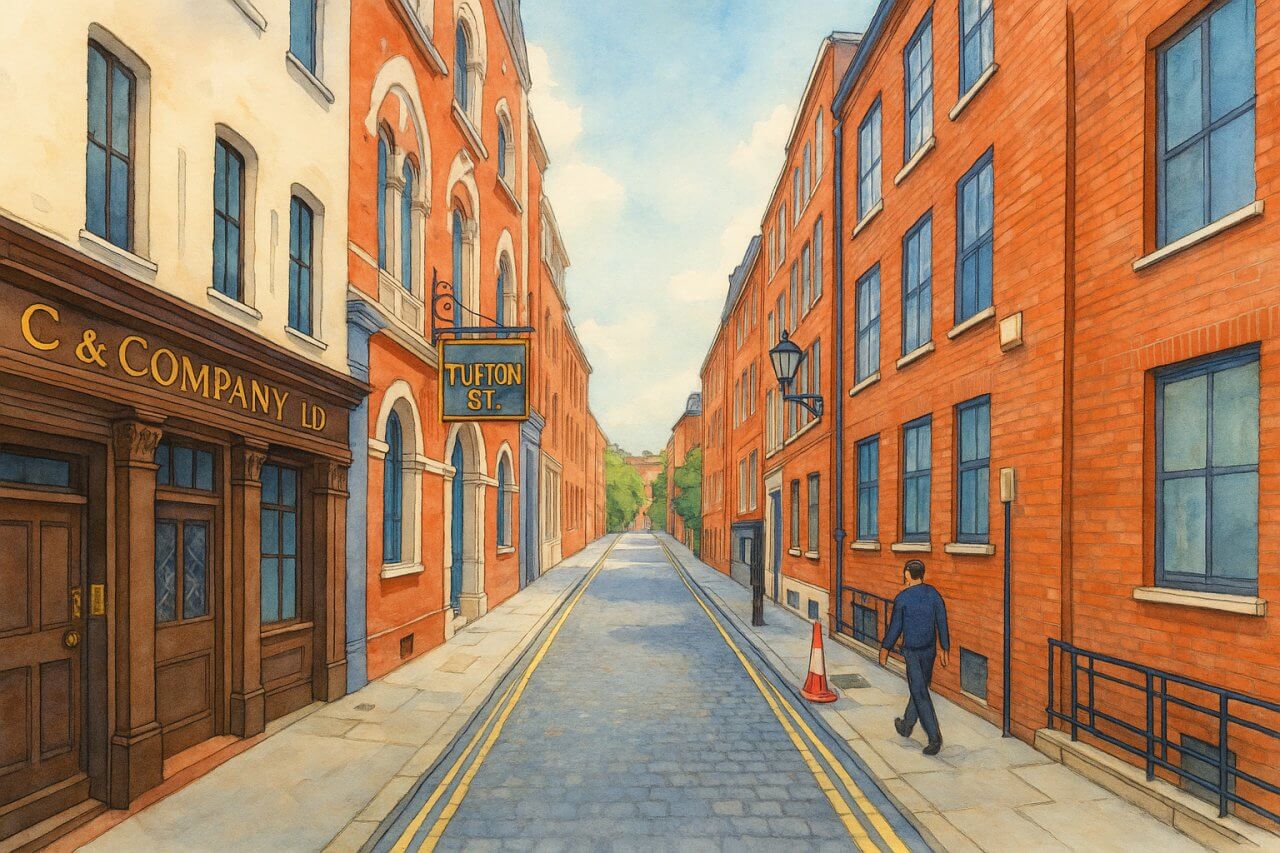
Tufton Street, London
Tufton Street, Westminster: History, Character and Real Estate
Tufton Street is located in the heart of Westminster, within the City of Westminster, central London. It connects Great College Street to Horseferry Road, running roughly north to south and lying just a short walk west of the Palace of Westminster and Westminster Abbey.
This narrow, historically rich street lies in a prestigious part of London, nestled among government buildings, institutions, and historic churches, making it a popular point of interest for those intrigued by British politics and history.
How Long is Tufton Street?
Tufton Street measures approximately 0.2 miles (around 320 metres) in length. Though not a major thoroughfare, it plays a notable role in connecting key civic spaces and institutions in Westminster. Its compact length belies its significance in political and cultural circles.
The History of Tufton Street
Tufton Street was laid out during the late 17th century, around the 1680s, as part of the development of Westminster that followed the restoration of the monarchy in 1660. The area was being steadily built up to accommodate the expanding population of London, particularly those affiliated with Parliament, the Church, and royal administration.
The street was once known for its ecclesiastical connections, with several clergy and church-related institutions housed here due to its proximity to Westminster Abbey and the Church House in nearby Great Smith Street.
Origin of the Name "Tufton Street"
Tufton Street takes its name from Sir Richard Tufton, a landowner and prominent figure in the 17th century who held estates in this area. The Tufton family had long-standing ties with the aristocracy and were involved in the development of this part of Westminster.
The street was formally named after the Tufton family in the late 1600s, likely in connection with land grants or investments made during that time. Naming streets after local aristocrats was a common practice in post-Restoration London.
Connecting Roads and Cross Streets
Tufton Street links Great College Street in the north to Horseferry Road in the south. Along its course, it intersects or connects closely with:
- Little Smith Street
- Old Pye Street (via small alleys)
- Great Peter Street (parallel to the west)
- Dean Bradley Street (near its midpoint)
These roads knit Tufton Street into a grid of historically significant and architecturally rich streets in Westminster.
Real Estate Prices and Property Sizes (as of April 2025)
Tufton Street is considered a high-value location, given its prestigious address in Westminster and proximity to Parliament and Whitehall. As of April 2025, property values on Tufton Street are estimated as follows:
- 1-bedroom flats: £925,000 to £1.1 million
- 2-bedroom flats: £1.5 million to £2 million
- Townhouses: £3.8 million to £6 million
Property sizes typically range from around 600 sq ft (56 sq metres) for smaller flats to over 2,500 sq ft (232 sq metres) for larger period townhouses.
These prices are significantly above the average for Greater London, reflecting Tufton Street’s desirable location, its period architecture, and its political and historical significance.
Character and Use of the Street
Tufton Street has a unique character that blends residential and institutional use. The street is lined with attractive Georgian and Victorian buildings, many of which have been converted into apartments, offices, and think tank headquarters.
While parts of it are residential, Tufton Street is especially known for housing several political organisations and lobbying groups, giving it an air of understated influence. Despite this, the street retains a quiet, almost village-like quality that is uncommon in central London.
Nearest London Underground Stations
Tufton Street is within easy walking distance of multiple London Underground stations:
- St James’s Park (District and Circle lines) – approx. 7 minutes' walk
- Westminster (Jubilee, District and Circle lines) – approx. 9 minutes' walk
- Victoria (Victoria, District and Circle lines) – approx. 12 minutes' walk
This excellent transport connectivity makes Tufton Street easily accessible from many parts of London.
A Fun Fact About Tufton Street
In recent decades, Tufton Street has become almost synonymous with British political lobbying and policy influence. Buildings such as 55 Tufton Street have been home to a network of right-leaning think tanks, advocacy groups, and media organisations.
This has made the address famous—or infamous—among political watchers, especially during the Brexit years, when several Tufton Street occupants were influential in shaping public policy and media narratives.
Because of this, "Tufton Street" is sometimes used in UK political commentary as a shorthand for behind-the-scenes influence and lobbying, much like "K Street" in Washington, D.C.
Quick Facts
- Location: Westminster, City of Westminster, London
- Length: Approx. 0.2 miles (320 metres)
- Named after: Sir Richard Tufton (17th century landowner)
- Connected roads: Great College Street, Horseferry Road, Little Smith Street
- Real estate prices: Flats from £925,000; houses up to £6 million (as of April 2025)
- Nearest Tube stations: St James’s Park, Westminster, Victoria
- Character: Residential and institutional, with political offices and think tanks
- Fun fact: Home to several influential political organisations at 55 Tufton Street
Map of Tufton Street, London

Painting of Tufton Street, London (View image in full size)